Inkwell
An inkwell is a small jar or container, often made of glass, porcelain, silver, brass, or pewter, used for holding ink in a place convenient for the person who is writing. The artist or writer dips the brush, quill, or dip pen into the inkwell as needed or uses the inkwell as the source for filling the reservoir of a fountain pen. An inkwell usually has a lid to prevent contamination, evaporation, accidental spillage, and excessive exposure to air. A type known as the travelling inkwell was fitted with a secure screw lid so a traveller could carry a supply of ink in their luggage without the risk of leakage.
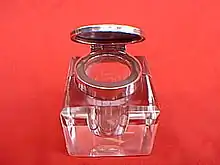
Origins
The inkwell's origins may be traced back to Ancient Egypt where scribes would write on papyrus. Knowledge of hieroglyphs was at the time highly restricted. Only scribes knew the full array of hieroglyphs and would write on the behalf of their employers, usually the pharaoh. After Rome invaded Egypt, inkwells became more popular in Italy as a larger percentage of the population were capable of writing.[1]
Inkwells gradually fell out of use in the early part of 20th century[2] as the reservoir fountain pen (which needs to be filled only occasionally) replaced the dip pen, which needed to be dipped in ink after writing a few lines. Old school desks had round holes for inkwells.[3]
Gallery
 Stands for dip pens and inkwells in the desks of student benches in the historic Chemical Auditorium of the Gdańsk University of Technology, 1904
Stands for dip pens and inkwells in the desks of student benches in the historic Chemical Auditorium of the Gdańsk University of Technology, 1904.png.webp) 3D model of a Roman Ritt. 13 inkpot
3D model of a Roman Ritt. 13 inkpot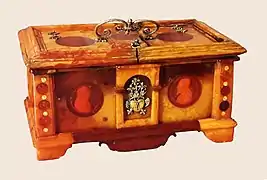
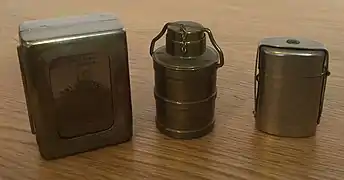 Examples of 19th century Travelling Inkwells
Examples of 19th century Travelling Inkwells Tudric pewter Inkwell
Tudric pewter Inkwell French school desks, c. 1900. The holes for the student's inkwells can be seen
French school desks, c. 1900. The holes for the student's inkwells can be seen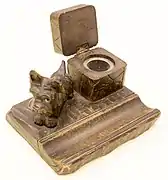 Inkwell, currently at the MEK
Inkwell, currently at the MEK Pallme-König & Habel - Inkwell - 2008.67 - Cleveland Museum of Art
Pallme-König & Habel - Inkwell - 2008.67 - Cleveland Museum of Art England or America, 19th century - Inkwell Set - 1961.172 - Cleveland Museum of Art
England or America, 19th century - Inkwell Set - 1961.172 - Cleveland Museum of Art.jpg.webp) Inkwell carved from anthracite - Cleveland Museum of Natural History
Inkwell carved from anthracite - Cleveland Museum of Natural History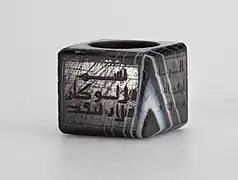 10th century medieval Islamic agate inkwell inscribed with Kufic script. Khalili Collection.
10th century medieval Islamic agate inkwell inscribed with Kufic script. Khalili Collection.
Bibliography
- The Collector's World of Inkwells, Jean & Franklin Hunting, Schiffer Publishing Ltd ISBN 0-7643-1102-6
- The Write Stuff Inkwells Pens & Desk Accessories, Ray & Bevy Jaegers, Krause Publications ISBN 0-930625-86-2
- McGraw's Book of Antique Inkwells Volume 1, Vincent D McGraw, published privately 1972
- Edwardian Shopping 1898-1913 selection facsimile, Army & Navy Stores, David & Charles ISBN 0-7153-7068-5
- Pens & Writing Equipment, Jim Marshall, Miller's ISBN 1-84000-066-X
- English Silver Hallmarks, Judith Bannister, W Foulsham & Co Ltd ISBN 0-572-01181-4
- Handbook of Pottery & Porcelain Marks, J P Cushion, Faber & Faber Ltd ISBN 0-571-04922-2
- Walter's Inkwells of 1885 Book 1, Leo G Walter, published privately 1968
- Inkbottles & Inkwells, William E Covill Jnr, William S Sullwold 1971
- Inkstands & Inkwells A Collector's Guide, Betty & Ted Rivera, Crown Publishers Inc,ISBN 0-517-50419-7
- Inkwells Identification & Values Book 1,Veldon Badders, Schroeder Publishing Inc, ISBN 0-89145-639-2
- Inkwells Identification & Values Book II, Veldon Badders, Schroeder Publishing Inc, ISBN 1-57432-020-3
- Western Writing Implements, Michael Finlay, Plains Books ISBN 1-872477-00-3
- Writing Antiques, George Mell, Shire Publications Ltd ISBN 0-85263-519-2
- Writing Implements & Accessories, Joyce Irene Whalley, David & Charles ISBN 0-7153-6903-2
- Yesterday's Shopping 1907 facsimile, Army & Navy Stores, David & Charles ISBN 0-7153-4692-X
- The Story of Writing, Donald Jackson, Studio Vista ISBN 0-289-70985-7
- The Enormous File, A Social History of the Office, Alan Delgado, John Murray ISBN 0-7195-3612-X
- Doulton Ink Wares, Colin Roberts, BEE Publications ISBN 0-9520547-0-1
- De Vito, C., Medeghini, L., Mignardi, S., Coletti, F., & Contino, A. (2017). (rome, italy): Production technology. Journal of the European Ceramic Society, 37(4), 1779–1788. 10.1016/j.jeurceramsoc.2016.11.044
See also
References
- Shanks, H. (2002). Scrolls, Scripts & Stelae. Biblical Archaeology Review, 28(5), 24.
- "The piston filling mechanism".
- "Schooling since 1913". 8 February 2021.